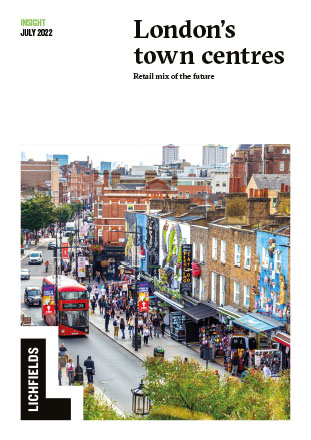Insights
London's town centres
Retail mix of the future
London’s town centres have and will continue to evolve to meet the needs and demands of their changing populations and customers. After years of consistent growth in the demand for retail floorspace however, many of London’s town centres are now beyond a ‘tipping point’ moment.
Already fundamentally changed by the ongoing growth of online shopping, the seismic shock of Covid-19 has resulted in massive shifts in footfall, spending habits and, at certain times, legal restrictions to using town centres in the way we had before.
To better understand what can be expected to happen in the future, we model the likely changes in the scale and composition of retail floorspace in London’s metropolitan, major and district town centres. Our analysis is projected for London, by town centre classification in response to the forecast population and residents’ retail spending projections. It is based on a model created using the GLA’s town centre floorspace and population data for London and Experian’s population and retail spending projections for the capital.
Our model’s ‘high-level’ projections, for a 2019 to 2035 time period, show a direction and scale of ‘net change’ in the four retail floorspace categories (convenience, comparison, food and beverages and cultural and entertainment) that make up the heart of most of London’s town centres, presented for each town centre classification.
Future changes in town centre retail floorspace are expected to be considerable. Taking London’s town centres as a whole, and across the retail categories, demand for floorspace is projected to increase by 3%. But there will be significant changes between uses. the projected drop in comparison retail floorspace ( -5%) and ‘flatlining’ of convenience retail floorspace change (+1%) is projected to be offset by the growth in food and beverage (+16%), and cultural and entertainment floorspace (+20%).
However, the projected outcomes for different classifications of town centres varies. Around half of metropolitan and major centres and two fifths of district centres are set to lose retail floorspace by 2035, mostly comparison floorspace in all centre classifications. All centre classifications are expected to gain cultural and entertainment and food and beverage floorspace. The projected outcomes for individual town centres also vary considerably, ranging from an increase of +40% in overall floorspace in some town centres, to a fall of -15% in others.
Our projections provide a greater understanding of the likely scale of upcoming changes in the retail composition across London's town centres. Recognising the scale of what may lie ahead can be used as a catalyst by those involved in the planning, place-shaping, development and management of London’s town centres to seize opportunities and adapt their centres in response to changing needs and different challenges.
Sectors

Download the report
Read the full report in PDF format.


